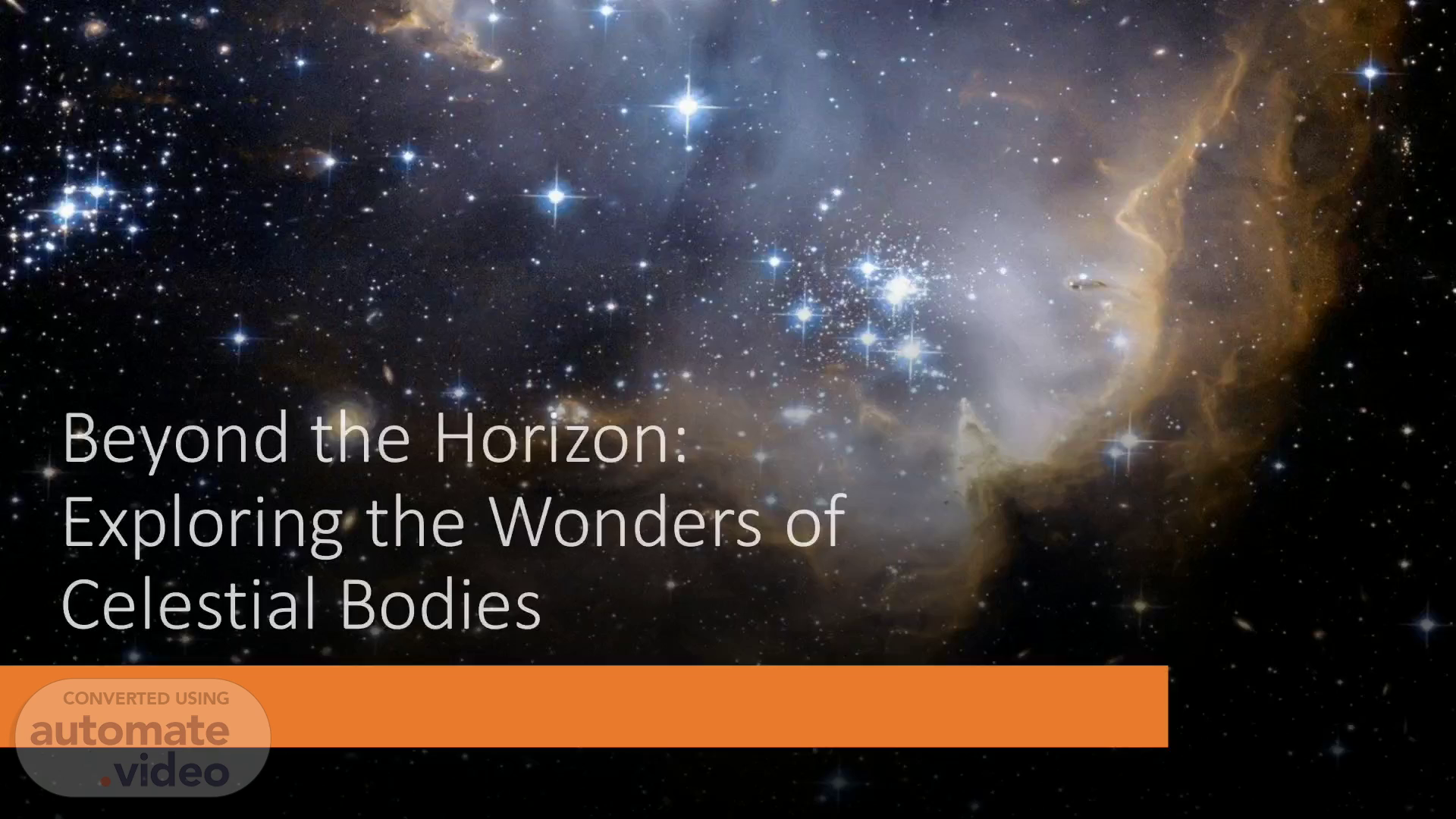Scene 1 (0s)
[Virtual Presenter] Beyond the Horizon: Exploring the Wonders of Celestial Bodies.
Scene 2 (11s)
[Audio] • Introduction to celestial Bodies • Types of Celestial Bodies • Formation of Celestial Bodies • The Importance of Studying Celestial Bodies • Famous Celestial Bodies • Conclusion.
Scene 3 (31s)
[Audio] Introduction to Celestial Bodies • The universe is a vast and mysteries place, filled with countless wonders that have fascinated humans for centuries. One of the most intriguing areas of study is celestial bodies- the stars, planets, moons, asteroids, and comets that populate our solar system and beyond. By studying these objects, we can gain a deeper understanding of the origins of the universe and our place in it. • But why are celestial bodies so important to study? For one, they offer us a glimpse into the past, allowing us to see how the universe has evolved over billions of years. • They also hold clues about the future, helping us to predict potential threats to our planet and to plan for space exploration and colonization. Finally, the study of celestial bodies inspires us to dream bid and to push the boundaries of what we know and understand about the universe.
Scene 4 (1m 36s)
[Audio] Types of Celestial Bodies • Celestial bodies are fascinating objects in the universe that come in various forms and sizes. The most common types of celestial bodies include stars, planets. Moons, asteroids, and comets. • Stars are massive balls of gas that emit light and heat through nuclear reactions at their cores. Planets are large bodies that orbit around a star and are often composed of rock or gas. Moons, on the other hand, are natural satellites that orbit around a planet. Asteroids are small rocky bodies that orbit around the sun, while comets are icy bodies that also orbit around the sun and often have a tail of gas and dust trailing behind them..
Scene 5 (2m 27s)
[Audio] Formation of Celestial Bodies • Celestial bodies are formed through a process called accretion, which involves the gradual accumulation of matter in space. This matter can come from various sources such as dust, gas, and other celestial bodies. As the matter accumulates ,it begins to exert gravitational forces on itself, causing it to clump together and form larger and larger objects. • There are several theories surrounding the formation of celestial bodies, including the nebular theory, which suggests that they form from the collapse of a giant cloud of gas and dust, and the tidal theory, which proposes that they form from the tidal forces of a passing celestial body. While these theories may differ in their specifics, they all provide valuable insights into how celestial bodies come into existence..
Scene 6 (3m 24s)
[Audio] The Importance of Studying Celestial Bodies • Studying celestial bodies is not just about satisfying our curiosity. it's also about understanding the origins of the universe and our place in it. By studying the stars, planets, moons, asteroids, and comets, we can learn about the processes that led to the formation of our solar system and beyond. • For example, studying the composition of celestial bodies can tell us about the conditions present during their information can help us understand how the early solar system evolved and how life on Earth came to be. Additionally, studying celestial bodies can help us to understand the potential for life on other planets and the challenges that may arise when exploring these worlds..
Scene 7 (4m 13s)
[Audio] Famous Celestial Bodies • The sun is the star at the center of our solar system .it is a nearly perfect sphere of hot plasma, with internal convective motion that generates a magnetic field via dynamo process. The sun's energy output supports life on Earth and drives our planet's weather and climate. • The moon is Earth's only natural satellite and the fifth largest moon in the solar system. It has a rocky surface with impact craters, mountains, and valleys. The moon's gravitational pull affects ocean tidies and has been explored by humans and robots alike. • Jupiter is the largest planet in our solar system and is known for its colorful bands od clouds and iconic Great Red Spot. Jupiter has dozens of moons, including the four largest known as the Galilean moons: lo, Europa, Ganymede, and Callisto. • Saturn is famous for its beautiful rings made up of ice particles and dust. The planet also has dozens of moons including Titan, which is larger than the planet Mercury and has a thick atmosphere that could potentially support life.. • Mars is often called the 'Red Planet' due to its reddish appearance caused by iron oxide or rust on its surface . Mars has polar ice caps ,canyons, and extinct volcanoes. It has been the subject of many robotic missions and is a potential target for future human exploration.
Scene 8 (5m 55s)
[Audio] Conclusion • IN conclusion, we have discussed the various types of celestial bodies such as stars, planets, moons, asteroids, and comets. We have explored how these bodies are formed and the different theories surrounding their formation. We have also highlighted the importance of studying celestial bodies and how it can help us understand the origins of the universe and our place in it, • As we look towards the future, it is important that we continue to study and explore the mysteries of the cosmos. By doing so, we can unlock new technologies, discover new worlds ,and gain a deeper understanding of ourselves and our place in the universe. So let us continue to gaze up at the stars and dream of what lies beyond..
